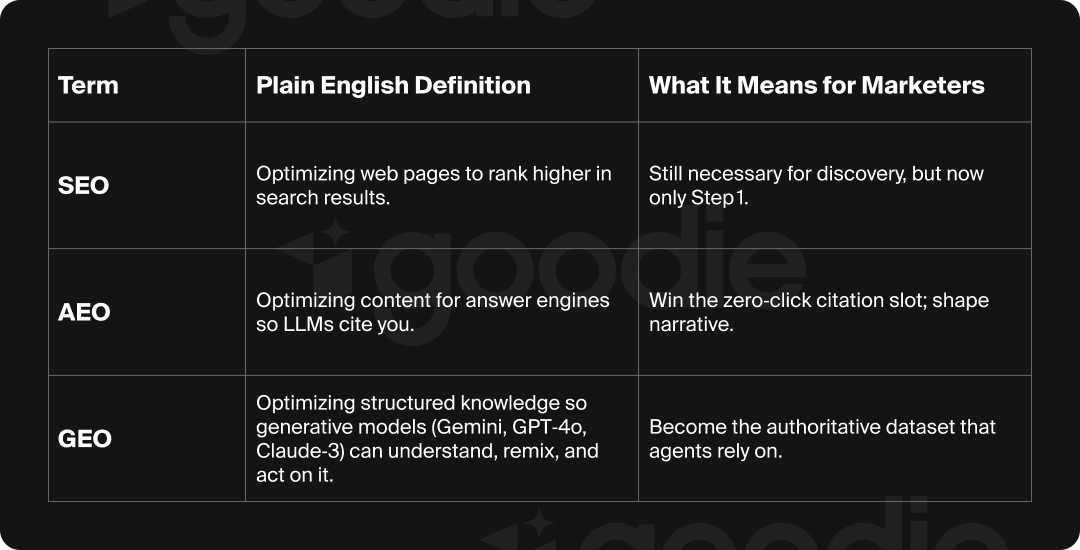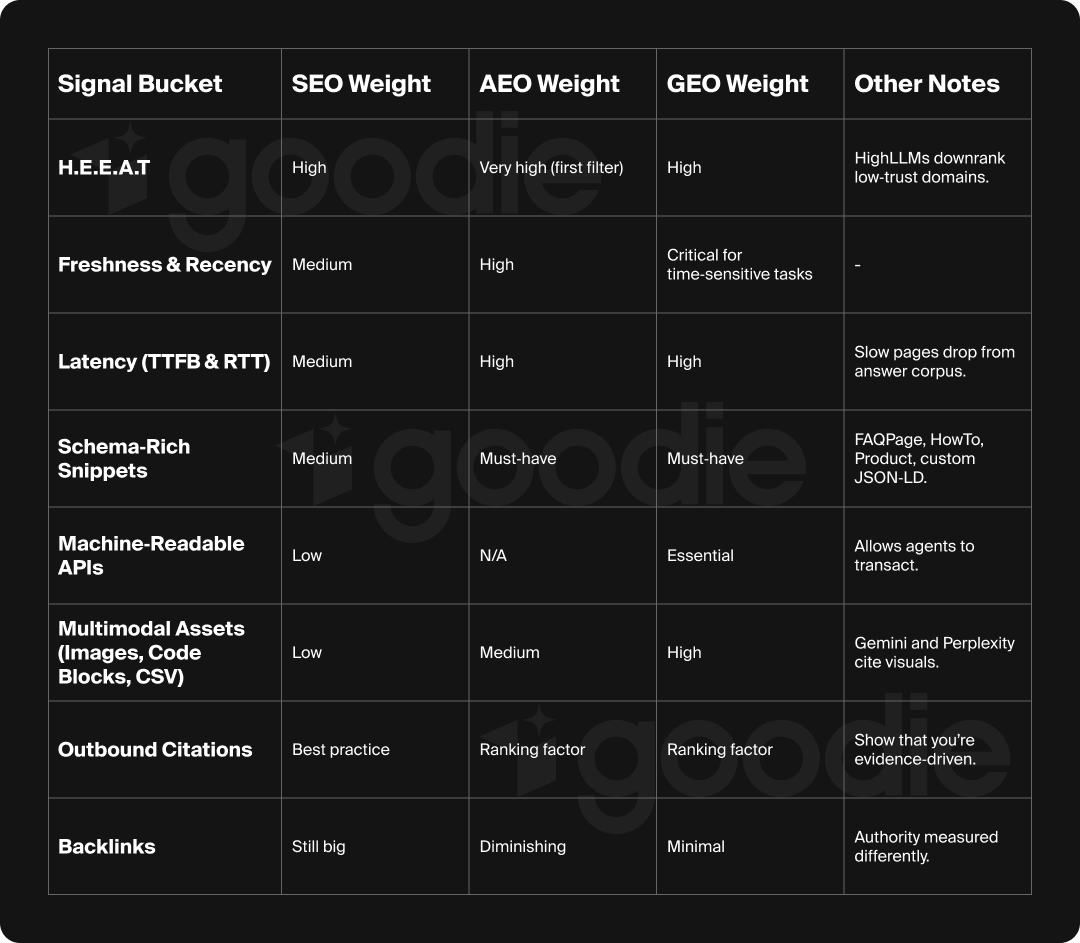

If you’ve read my other blogs, you’ve probably heard of AEO by now.
But now you might be wondering: what’s generative answer optimization (GEO), and is it the same thing as AEO?
You may have heard GEO being used interchangeably with AEO, but make no mistake– the concepts are distinct.
If you want durable brand visibility in the AI and agentic-first web, you must win across all three surfaces: SEO, AEO, and GEO.
The growing importance of GEO signifies a transition from optimizing for pages to optimizing for answers, and ultimately, to optimizing for actions. We broke down that transition for you here:

(You’re welcome to use this table, as long as you credit Goodie AI 😉)
People are increasingly turning to AI and answer engines to meet their search needs. Why? Because people believe generative answers are generally more concise, immediate, and personalized to their needs. Here’s what you need to know:
Believe me yet? The implication of this shift is drastic: no longer is it just a fight for visibility from lists of links to definitive answers; get ready for AI agents to start performing autonomous actions.
If your data isn’t optimized for LLM retrieval today, your brand won’t even be considered tomorrow when these agents are booking trips or choosing vendors.

Think of AEO’s end goal as “be quoted” and GEO’s as “be the source the agent fetches and executes on.”
Essentially, for AEO, you’ll measure success by analyzing your brand’s presence in a generative answer; with GEO, you’ll measure it by how often agents treat your brand as a dataset to perform tasks for users.
The TL;DR is:
To understand just how important optimizing for agentic AI is, you first have to grasp how AI models reason, retrieve, and act on your data.
This is the foundational SEO step. A search engine bot, like Googlebot, discovers and reads your webpage. The content is then added to a searchable index.
The engine evaluates hundreds of factors, from the quality of backlinks to technical performance (Core Web Vitals) and how well the content matches a user's intent.
When a user searches for something, the engine returns a ranked list of blue links, and then clicks on a link to get their answer.
The user's query is received by an LLM, which expands the query's meaning and performs an efficient search over a curated index of information.
Snippets of text from authoritative sources are injected into the LLM's context window.
The model synthesizes these passages into an answer, usually providing citations. This snapshot is typically between 3-5 paragraphs long when shown to the user, allowing them to get their answer without a click.
An agent takes a goal from a user (e.g., "book a trip") and breaks it down into a series of actionable steps.
To complete these steps, the agent calls external tools and APIs, such as a flight booking site or a hotel review service, using your structured data as its source.
The agent then executes the workflow, from comparing prices to completing a booking or sending a confirmation email, all without the user scrolling through a SERP. Your goal is for the agent to complete the task using your business as its partner.
The criteria for what an AI considers a "valuable" and "authoritative" source have changed. We’re starting to see a shift from traditional, link-based ranking toward a new set of signals that prioritize trust, speed, and the ability to enable action.

This new reality redefines the concept of authority. The old currency of the web was backlinks and crawlability. The new currency is H-E-E-A-T, schema-rich data, and API accessibility. An AI agent doesn't care about a link; it cares about the recency of your data, the integrity of your sources, and its ability to act on your information directly.
You shouldn’t abandon what you already know about SEO and AEO. Instead, think of SEO, AEO, and GEO as separate but intersecting disciplines that can build upon your existing framework.
Since SEO, AEO, and GEO have overlapping principles, here are some guidelines to consider:
Once you’ve applied these foundational SEO principles to your website and brand strategy, further tweak your content to adhere to these core principles of AEO:
Now you need to take your brand from being cited to being the dataset, helping agents use your content to take action.
Break down complex guides and documentation into machine-readable formats. Think beyond blog posts and create reusable objects like JSON files, CSV data, or embeddable diagrams so agents can easily pull the information they need to complete a task.
Create a vector embedding of your key documents (e.g., product manuals, research papers), host them, and expose them via an API. This allows an agent to perform a semantic search against your knowledge base and retrieve facts without scraping a webpage.
Build and secure public-facing APIs that allow agents to transact with your business. These APIs are what agents will use to check real-time pricing, verify inventory, or complete a booking.
Most modern models are multimodal, meaning that they can understand more than just text. Ensure your images have descriptive alt-text, your videos have transcripts, and your data visualizations are accompanied by CSV files or captions, which can help agents act on your visual and data assets.
You need to be actively testing these strategies to make sure they hold up. You can run adversarial prompts to see how an AI model cites you, which will help you identify "hallucination triggers" or cases where the model misinterprets your content. Use this information to patch your content and ensure the model cites you accurately and as intended.
If you don’t know where to start, here’s a checklist we made to help you with your GEO efforts.

You might be reading all this and feeling overwhelmed. Try not to worry, though; we’ve put together a list of all the textbook tools you can add to your arsenal to streamline your SEO, AEO, and GEO strategy.

You might have noticed Goodie pops up frequently in this list. Why? Because traditional SEO dashboards stop at click data. Taking it a few steps further, Goodie correlates answer‑engine exposure, sentiment, and eventual agentic conversions; metrics your CFO will soon care about.
If you only have one team dedicated to all things optimization, you won’t get very far. Your entire team has to be on the same page about these efforts, which is why we’ve broken down the evolution of traditional marketing roles within this new context.

Forward-leaning teams don’t run independently; they run in parallel, sharing a central knowledge engineering function that owns schema, embeddings, and APIs. Consider building in-house SEO, AEO, and GEO squads to complement each other’s efforts and avoid placing too much burden on one team.
Remember that you’re now targeting an ecosystem of agents, not a library of pages. With this in mind, keep the following in mind:
When you zoom out: Traditional SEO still drives top‑of‑funnel discovery, but answer engines own mid‑funnel trust, and generative agents will own bottom‑funnel action. Winning brands will implement a blend of all three.
It's easy to get lost in the technical weeds of AEO and GEO with all of this information about vector databases, APIs, and LLMs. But at the end of the day, all of these strategies are still about one thing: people. While we're optimizing our content for machines, the ultimate goal is to serve human beings.
Think of it like this: AI models are intermediaries between you and your audience. The old path a customer would take was typing a query into the search bar, finding a relevant link, and clicking it. The new path is a customer asking a natural-language question to an LLM, receiving an answer, and then taking action.
Your content needs to be so good, so helpful, and so trustworthy that the AI can't help but cite you. This means focusing on the human side of things:
When you create content with the human user in mind, you're building a durable, trustworthy brand for the future. The metrics and technology will inevitably change again, but a brand's true value is built on the trust it earns.
Measuring success through impressions, clicks, and traffic is becoming outdated. In a world of zero-click searches and agentic conversions, we need new ways to prove value.
Here's the new reality:
This isn't about completely replacing the old metrics, but about adding a new layer to measurements. By focusing on citations and agentic actions, you can show your company's leadership the impact of your work in a world where AI is doing the heavy lifting for customers.
And remember…
Search is no longer a page of links.
It’s an answer, then an action.
Master SEO to be found, AEO to be quoted, and GEO to be used.
Do it now before the agents decide for your customers.
That's a great question, and it gets to the heart of the matter. While AEO and featured snippets are related, they're not the same. Featured snippets were a big step toward answering questions directly in the search results, but they were still a direct extraction of content from a single webpage, not a synthesized answer from generative AI.
AEO encompasses a much broader process. Current AI Overviews and answer engines don't plant a snippet at the top of the SERP; they generate original prose by synthesizing information from multiple sources. They do this by reading a few top-ranking articles, a couple of authoritative research papers, and maybe a few other relevant facts to write a new, unique summary.
This means you're not just competing for a single snippet; you're trying to be one of the trusted sources that the AI uses to form its answer. Your goal is to "be quoted" in this newly generated prose, which is a strategic challenge.
Yes, but their role has changed. Backlinks used to be the most important signal for Google, acting as a vote of confidence from one website to another. Now, AI models place a much higher value on what we call entity-level authority.
Instead of just looking at the number of links pointing to your site, AI is asking:
A quality backlink from a respected source still helps, but a flood of low-quality links is far less effective than it used to be. The focus has shifted from "Who links to you?" to "Who trusts you, and why?"
For now, you might get by, but it's a short-term solution. Think of AEO as about getting your brand quoted, and GEO as getting your brand chosen.
As AI assistants get smarter, they won't just provide an answer; they'll offer to complete a task. If a user asks, "What's the best time to book a flight to London?" AEO might get you cited in the answer.
However, a GEO-optimized brand with a machine-readable API can then act as the source the agent uses to book that flight. If you only do AEO, you'll be giving away the most valuable conversions to the brands that mastered GEO. To truly win, you need both.
No, you don't need to rebuild your site from scratch. This is an evolution, not a complete rebrand. Most AEO and GEO strategies can be implemented within your existing website by making smart, intentional changes.
For AEO, this means adding FAQ sections, using schema markup, and writing in an "answer-first" format. For GEO, it might mean creating a structured data feed or an API for your product catalog or service offerings.
Think of it like installing the latest smart technology in your house– The foundation is still there, you’re not completely remodeling it. The key is to start thinking about your content as a set of structured knowledge blocks rather than just a collection of webpages. While dedicated tools can help, you can start making significant progress with the components you already have.


